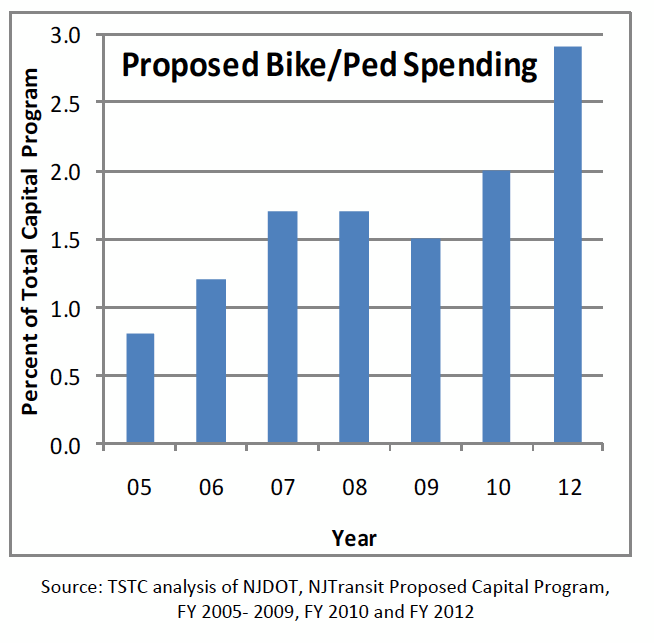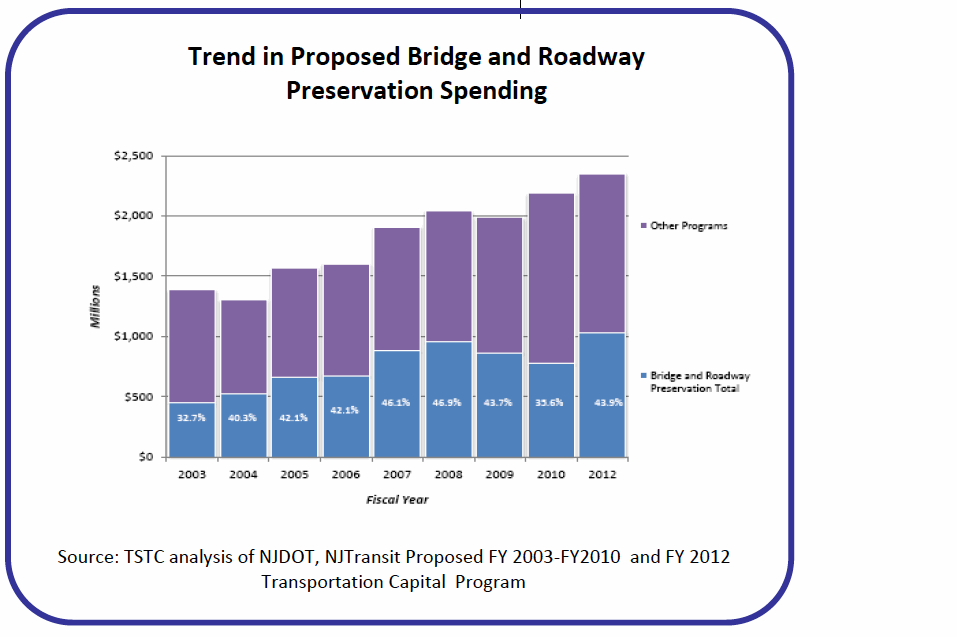TRI-STATE TRANSPORTATION CAMPAIGN
Executive Summary
New Jersey’s draft fiscal year 2012 capital program provides almost $3.5 billion in funding for the state’s road and transit systems, with approximately $2.3 billion (66%) going to New Jersey Department of Transportation and $1.164 billion (33%) set aside for New Jersey Transit investments.
The Tri-State Transportation Campaign has closely analyzed the NJDOT portion of the capital program, comparing funding levels across project types, and examining trends in past spending priorities.
From this analysis, several themes have emerged:
1. Road and bridge maintenance continue to make up the largest percentage of NJDOT’s capital program budget. The agency is dedicating 44% of the fiscal year 2012 capital spending to rehabilitation, repair, resurfacing, and replacement projects. NJDOT must prioritize a “fix-it-first” strategy given the poor condition of the state’s existing infrastructure.
2. Spending on road and bridge capacity expansion projects makes up 11% of the capital program, the largest percentage in nearly a decade, threatening to undermine the state’s “fix-it-first” goals.
3. Funding for signature smart growth programs has been reduced or eliminated. The capital pro-gram defunds the popular Transit Village and Centers of Place programs. In addition, projects that are part of the NJ Future in Transportation (NJ FIT) program have been cut.
4. Funding for bicycle and pedestrian projects shows NJDOT’s commitment to pedestrian and bicyclist safety. At nearly 3% of the proposed capital program, NJDOT remains a national leader in spending on this area. Sustained funding is critical if the state hopes to continue to reduce bicyclist and pedestrian deaths.
Recommendations for the Governor, State Legislature and NJDOT:
- Recommit to the fix-it-first policy mandated in 2000 to reduce the backlog of deficit roads and bridges by half as the state approves the Transportation Capital Program this year.
- Take a hard look at proposed road expansion projects and call off projects that will not offer sustainable congestion relief. If the state could not afford the ARC passenger tunnel project, it cannot afford paying for road expansion projects that do little to reduce traffic congestion.
- Create a consistent fix-it-first policy among all state transportation agencies, including NJDOT and the New Jersey Turnpike Authority.
- Restore and increase funding for the state’s smart growth programs to ensure continued progress on these initiatives. Dedicate at least $1 million annually to NJ Transit Village program and the Centers of Place program. Launch a new round of NJ FIT projects that help towns plan for the future.
- Continue to fund bicycle and pedestrian projects, targeting financial support to places with the highest number of pedestrian and bicyclist injuries and deaths. Restore funding to the Safe Routes to Transit program to at least $1 million annually.
- Use money previously earmarked for Access to the Region’s Core for its intended purpose of im-proving the cross-Hudson commute.
- Find new sources of revenue. The proposed capital program relies on $1.8 billion in transfers from the state’s General Fund over five years, revenues that presently do not exist.
Download full version (PDF): A Bumpy Road Ahead?
About Tri-State Transportation Campaign
www.tstc.org
“The Tri-State Transportation Campaign is a 501(c)(3) non-profit organization dedicated to reducing car dependency in New York, New Jersey, and Connecticut. Leading environmental and planning organizations formed the Campaign in the early nineties as a response to the mounting economic and environmental costs of automobile and truck dependence and promising reforms in federal transportation policy.”
Tags: Department of Transportation, New Jersey, NJ, NJDOT, Tri-State Transportation Campaign, TSTC








 RSS Feed
RSS Feed